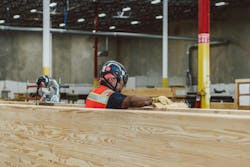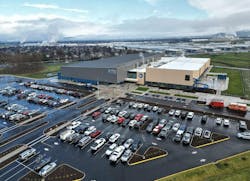Timberlab to build its first mass timber manufacturing plant
By John Caulfield, Senior Editor
In 2023, mass timber used for construction globally was, by one estimate, valued at $1 billion. Cross-laminated timber (CLT) captured 47 percent of that market, and 51 percent of the mass timber produced was installed for residential projects, according to the market research firm The Brainy Insights. Demand for mass timber is expected to climb to $2.15 billion by 2033.
Right now, there are five CLT manufacturing plants operating in the U.S., owned by three companies. Timberlab, the Portland, Ore.-based subsidiary of the general contracting firm Swinerton that provides turnkey solutions for mass timber construction, is concerned that supply could be a pinch point in the future. “We need a more robust supply chain,” asserts Chris Evans, Timberlab’s president.
Timberlab already operates two mass timber CNC facilities, in Portland and Greenville, S.C. Earlier this month, the company disclosed its plans to open its first CLT manufacturing plant, a 250,000-sf facility in Oregon’s mid-Willamette Valley.
Evans declined to disclose the projected cost of the plant, or its exact location except to say it would be “south of Portland and north of Bend [Ore.].” Timberlab is working with Lever Architects and Kimley-Horn on this project, for which Swinerton will be the core-and-shell contractor.
Timberlab is targeting a January 1, 2027 date to begin production at the new plant, which will have a 100,000-cubic-meter production capacity. Evans expects the plant to reach full capacity within five to seven years of its opening.
The CNC facilities sell product to other installers and contractors beside Timberlab and Swinerton, and Evans says the manufacturing plant will do the same; non-Timberlab companies are likely to account for a “big part” of the plant’s customer base.
Evans says the CLT manufacturing plant illustrates Swinerton’s commitment to expanding mass timber as a building material. “We’ve been at this for seven years, and demand continues to rise,” he tells BD+C. “And what’s most encouraging is that demand isn’t limited to urban centers.” He points specifically to the 140,000-sf Rogue Credit Union Community Complex building in Medford, Ore., which includes 30 glue-laminated columns, 15 hybrid (mass timber and steel) trusses, and 88 CLT roof panels covering a 30,000-sf space for two swimming pools, tennis and basketball courts, a gym, and fitness classes.
Codes, demand lean in mass timber’s favor
A few weeks before Timberlab announced its plans for the CLT manufacturing facility, Swinerton’s regional office in New York hosted a panel discussion on mass timber market and, specifically, its demand in metros like New York.
Mass timber “is a great step toward reducing CO2 emissions, and we’re seeing the market for it expanding,” especially for multifamily and industrial construction, said Taylor Landry, PE, MLSE, Technical Director for Woodworks|Wood Products Council. Landry also attempted to allay concerns, expressed in some environmentalist corners, that a serious bump in mass timber demand would be detrimental to forest management.
The panelists were bullish on mass timber’s future. “Our mission is to mainstream mass timber,” stated Tanya Luthi, Timberlab’s director of engineering, who talked about several of her firm’s recent mass timber projects that include a nine-acre mass timber roof for the main terminal at Portland International Airport, which should be ready to open in May. She also noted how tests of mass timber structures are meeting or exceeding more rigid fire-resistance and seismic ratings.
The engineering firm Thornton Tomasetti has a mass timber project in development for New York City that would be 30 stories tall. Eli Gottlieb, the firm’s Managing Principal, said that Thornton Tomasetti can now bring in mass timber projects that are cost competitive with steel or concrete. Deploying mass timber will also help his firm’s goal of achieving carbon neutrality by 2030.
Charles Besjak, PE, SE, FAIA, LEED, Principal of Structural Engineering for Skidmore, Owings and Merrill, said that mass timber is a major element in the design and construction of New York Climate Exchange, a climate solutions center on Governors Island that SOM and Stony Brook University are creating in collaboration with Mathews Nielsen Landscape Architects, Buro Happold, and Langan Engineering. The building will showcase sustainability and resilience, and is scheduled for completion in 2028.
A mindset shift toward mass timber
“There’s been a change in mentality” about using mass timber, Besjak told BD+C, among developers, contractors, and municipalities.
Gizem Karagoz has also seen what she called a “behavioral change” toward mass timber. As Senior Project Manager with the New York City Economic Development Corp.(NYCEDC), Karagoz has been working with the city’s Department of Buildings to use mass timber for larger buildings. She said that that New York wants to lead “from the front” on mass timber’s installation for more building sizes and shapes.
Luthi said the next step in mass timber’s evolution will be full-scale fire testing “to get a handle on fire’s behavior in taller buildings.”
William Silva, Swinerton’s Director of Preconstruction told BD+C that his company expects to build 20 percent faster when using mass timber, which can be customized and preassembled into kits of parts. He added that because of its relative lightness, compared to other building materials, and carbon sequestration potential, mass timber could become a “catalyst” for spurring new construction projects.

